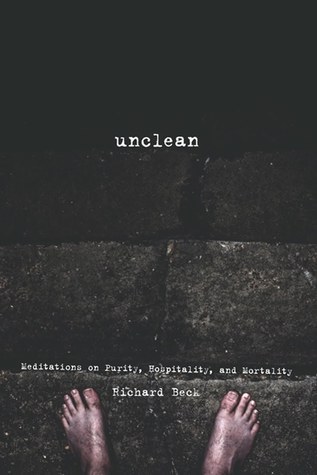More on this book
Community
Kindle Notes & Highlights
by
Richard Beck
Read between
July 30 - August 20, 2015
what makes these theological beliefs so appealing? Why do they “feel right” to so many people? If we had good, solid answers to these questions we might be better positioned to educate and lead the church.
Let’s pause here and update our list of features that characterize disgust psychology. We’ve already noted the boundary monitoring, expulsive, and promiscuous aspects of disgust. We can now add a fourth feature to our list: 1. A Boundary Psychology: Disgust is a system that monitors boundaries. Disgust regulates the act of incorporation and inclusion. 2. Expulsive: Disgust is a violently expulsive mechanism. In mild forms disgust simply prompts withdrawal and avoidance. In stronger forms disgust involves violent rejection, expulsion, or elimination. 3. Promiscuous: Due to disgust’s
...more
I’d like to focus on four principles of contagion as have been described by Paul Rozin and his colleagues: 1. Contact: Contamination is caused by contact or physical proximity. 2. Dose Insensitivity: Minimal, even micro, amounts of the pollutant confer harm. 3. Permanence: Once deemed contaminated nothing can be done to rehabilitate or purify the object. 4. Negativity Dominance: When a pollutant and a pure object come into contact the pollutant is “stronger” and ruins the pure object. The pure object doesn’t render the pollutant acceptable or palatable.4
Negativity dominance has important missional implications for the church. For example, notice how negativity dominance is at work in Matthew 9. The Pharisees never once consider the fact that the contact between Jesus and the sinners might have a purifying, redemptive, and cleansing effect upon the sinners. Why not? The logic of contamination simply doesn’t work that way. The logic of contamination has the power of the negative dominating over the positive. Jesus doesn’t purify the sinners. The sinners make Jesus unclean. Negativity dominance is problematic
What is striking about the gospel accounts is how Jesus reverses negativity dominance. Jesus is, to coin a term, positivity dominant. Contact with Jesus purifies. A missional church embraces this reversal, following Jesus into the world without fears of contamination. But it is important to note that this is a deeply counterintuitive position to take. Nothing in our experience suggests that this should be the case. The missional church will always be swimming against the tide of disgust psychology, always tempted to separate, withdraw, and quarantine.
But Girard suggests that, at the height of communal violence, many cultures took an alternative route, a tragic but effective route. For some reason, different at different times and places, the ire of the group fell upon a certain person or subgroup. A scapegoat for the collective misfortune was identified. And in that moment of identification, group solidarity miraculously reappears.
as Nietzsche warned in Beyond Good and Evil: “Whoever fights monsters should see to it that in the process he does not become a monster.”
Now you might be wondering, am I being too harsh? Is this server really seen as “not fully human”? The answer might surprise you. The anthropologist Levi-Strauss once wrote that “Humankind ceases at the border of the tribe.”4 We’ve already seen, given Singer’s notion of the moral circle, that how we treat people depends upon whether they are a part of my “tribe.” But Levi-Strauss’ comment is stronger. Does humanity end at the edge of the moral circle? That is, is the way we treat people outside the moral circle symptomatic of something darker and more sinister? Do we see outsiders as less than
...more
analysis is no idle or theoretical speculation.
A key observation has been the recognition that disgust and love are reciprocal processes. Disgust is the primary process erecting boundaries between the self and the world. Love is a secondary process that allows others access to the “territory of the self.” This access is physical (allowing kinds of physical touch, intimacy, or proximity), social (creating intimate webs of friends and family), behavioral (allowing people inside one’s moral circle and granting them special claims on our time, effort, and resources), and emotional (granting access to warmth and acceptance within our hearts and
...more
Is our ambivalence concerning the Incarnation a flight from our own need, dependency, and vulnerability? Our discussions over the last few chapters seem to answer in the affirmative. Our utter dependency is nowhere more manifest than in our vulnerability to death. In fact, death is what defines human need. The forces of death are always at work in my body. And to fend off death, I must eat and excrete. I am always moving into hunger, always in need. And if I eat, I must defecate and urinate. The whole metabolic cycle is driven by the forces of death and decay and my daily efforts to fend them
...more
Taylor suggests that the moral intensification on the laity (along with disenchantment) made morality the telos, the goal of the Christian faith. What we owe God is goodness. As a result of disenchanted reform, Christianity became less spiritual but more moral.
Consequently, in reform we see religious groups applying instrumental, mechanistic reason to solve the problem of morally educating the polis. Reform goes civic. This moral and civic reform, the implementation of a kind of “moral engineering,” was most clearly seen in Calvin’s Geneva. In effect, the entire city or nation becomes the monastery. Spirituality goes political.
In short, if goodness (or its more public face “civility”) is the goal, and if reason alone can be used to create well-functioning moral communities, then God and the sacred becomes less and less important. Reason and nature become guides to the good life, politically understood. God grows more distant, mainly thanked for creating reason and a morally coherent universe. The moral core of this civic and political existence would be for citizens to practice a “universal beneficence” that would foster peace and a well-functioning society. This “universal beneficence” became the hallmark of
...more


